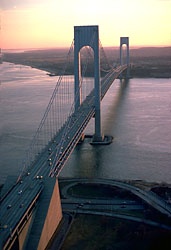Brooklyn
borough, New York City, New York, United States
 one of the five boroughs of New York City, southwestern Long Island, southeastern New York, U.S., coextensive with Kings county. It is separated from Manhattan by the East River and is bordered by the Upper and Lower New York bays (west), the Atlantic Ocean (south), and the borough of Queens (north and east). Brooklyn is connected to Manhattan by three bridges (one of which is the Brooklyn Bridge), one vehicular tunnel, and several rapid-transit tubes; to Queens and Long Island by parkways; and to Staten Island by the 4,260-foot (1,298-metre) Verrazano-Narrows Bridge.
one of the five boroughs of New York City, southwestern Long Island, southeastern New York, U.S., coextensive with Kings county. It is separated from Manhattan by the East River and is bordered by the Upper and Lower New York bays (west), the Atlantic Ocean (south), and the borough of Queens (north and east). Brooklyn is connected to Manhattan by three bridges (one of which is the Brooklyn Bridge), one vehicular tunnel, and several rapid-transit tubes; to Queens and Long Island by parkways; and to Staten Island by the 4,260-foot (1,298-metre) Verrazano-Narrows Bridge.The first settlement in the area by Dutch farmers in 1636 was soon followed by other settlements in Flatlands, Wallabout, the Ferry, Gravesend, and, in 1645, Breuckelen—also spelled Breucklyn, Breuckland, Brucklyn, Broucklyn, Brookland, and Brookline (the present spelling became fixed about the close of the 18th century). Later settlements included New Utrecht (1650), Flatbush (1651), Bushwick, and Williamsburg (1660). The American Revolutionary Battle of Long Island (Long Island, Battle of) was fought in Brooklyn on Aug. 27, 1776, with remnants of the American army retreating to Brooklyn Heights overlooking the East River. In 1816 the most populous section of Brooklyn was incorporated as a village and in 1834 as a city. In 1855 Williamsburg and Bushwick were annexed to it; other communities were absorbed until the city of Brooklyn became conterminous with Kings county (created 1683). Brooklyn became a borough of New York City on Jan. 1, 1898.
Brooklyn is both residential and industrial and also handles a vast amount of oceangoing traffic. It is a western terminus of the Long Island Rail Road. There are many educational institutions, including Pratt Institute (1887) and branches of the Polytechnic University, the City University of New York, the State University of New York, and Long Island University. Several colonial churches (including Plymouth Church of the Pilgrims, where Henry Ward Beecher preached), Coney Island, the Brooklyn Botanic Garden and Arboretum, the Brooklyn Museum, and the Brooklyn Children's Museum are in the borough. Famed native sons include composer George Gershwin, lyricist Ira Gershwin, filmmaker Woody Allen, and writers Arthur Miller and Norman Mailer. Area 71 square miles (184 square km). Pop. (2000) 2,465,326; (2007 est.) 2,528,050.
- United Artists Corporation
- United Australia Party
- United Automobile Workers
- United Church of Canada
- United Church of Christ
- United Daughters of the Confederacy
- United Development Party
- United Evangelical Lutheran Church
- United Evangelical Lutheran Church of Germany
- United Farm Workers of America
- United Free Church of Scotland
- United Front
- United Fruit Company
- United House of Prayer for All People
- United Ireland Party
- United Irishmen, Society of
- United Kingdom
- United Kingdom, flag of the
- United Methodist Church
- United Mine Workers of America
- United Nations
- United Nations Capital Development Fund
- United Nations Conference on Environment and Development
- United Nations Conference on Trade and Development
- United Nations Development Programme